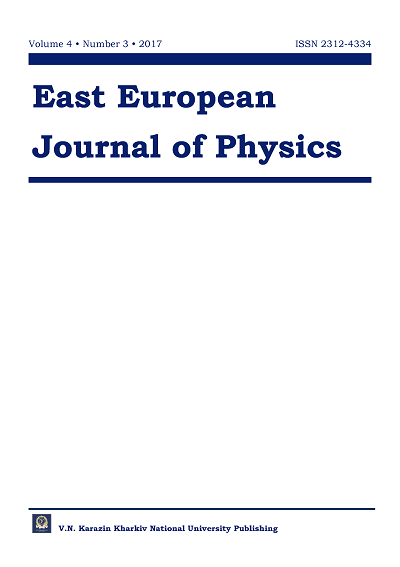ЩОДО ПИТАННЯ ПРИРОДИ ТЕТРАГОНАЛЬНОСТІ МАРТЕНСИТУ
Анотація
Не дивлячись на те, що вивченням природи мартенситоутворення вчені займаються вже майже сто років, ці дослідження залишаються як і раніше актуальними. В цій роботі автори представляють два нових результати , які пов’язані з класичним питанням щодо ролі вуглецю у у мартенситних перетвореннях. Якщо у твердому розчині кристалічної гратки вуглець знаходиться у центрі октоедрічної пустоти, то під впливом напружень, що викликані гартуванням або деформацією, у мартенситі він зміщується у бік одної з пірамід, що створюють октаедр. У роботі вперше показана незалежність питомого атомного об’ єму фазової невідповідності заліза при мартенситних перетвореннях від вмісту вуглецю. Цей факт свідчить, що тетрагональність вуглецевих сталей є функцією не тільки вуглецю , але передусім-вакансій. У чистому залізі « вакансій на » тетрагональність може змінюватись у межах від 1 ,03 до 1,06.
Завантаження
Посилання
2. Guliaev A.P. Metall Science. – M.: Oborongiz, 1963. – 185p. (In Russian)
3. Oshkaderov S.P. Phase transformation in austenite // Progress in Physics of Metals. – 2011. – Vol.12. – P.269-293. (In Russian)
4. Koval Yu.N., Lobodyuk V.А. Deformation and relaxation phenomenas during martensite transformation. – Kiev: Naukova Dumka, 2010. – 297p. (In Russian)
5. Meshkov Yu.Ya. On the problem on martensite tetragonality. // Proc. Int. Conf. “The modern problems of metal physics and physics of metallic systems” / Ed.IMF NANU, Kiev. – 2527.05. – 2016. – P.22. (In Russian)
6. Kaminsky E.E., Percas M.D. Metal science problems. – М.: Metallurgiya, 1949. – 211p. (In Russian)
7. Arbuzov М.P. Metal physics and science problems. – Kiev: Academy of Sci. Edition. – 1955. – No. 6. – P. 3-11. (In Russian)
8. Kurdyumov G.V., The quenching and aging phenomenas in steel. – М.: Metallurgiya, 1960. – 140 p.
9. Kurdyumov G.V., Utevsky L.M., Entin R.I. Transformations in iron and steel. – М.: Nauka, 1977. – 238p. (In Russian)
10. Kurdyumov G.V., Lysak L.I. X-rays study of aging martensite // Journal of technical physics. – 1947. – Vol. 17. – P.525-531. (In Russian)
11. Lotkov. А.I, Baturin А.А. Martensite transformation in NiTi alloys // Physical mesomechanics. – 2011. – Vol.14. – No. 3. – P. 69-84. (In Russian)
12. Lobodyuk V.А., Meshkov Yu.Ya. On the problem on martensite tetragonality in carbon steel // Metal physics and new technology. – 2017. – Vol.39. – P.122-130. (In Russian)
13. Laptev I.M., Parkhomenko O.O., Tkachenko V.I. The dualism of the vacancy nature in nonequilibrium systems // East European Journal of Physics. – 2016. – No.3. – P.113-120.
14. Morozov О.P., Mirzayev D.A., Schteinberg М.М. The speed quenching impact in iron // Metal physics and Metal science. – 1987. – Vol. 32. – No. 6. – P. 1290 – 1297. (In Russian)
15. Damask А., Dins J. Point defects in metals. – М.: Мir, 1966. – 291p.
16. Rokhmanov N.Ya., Laptev I.N., Onishenko I.P., Parkhomenko O.O. Structural features of Fe-Al vacancy system // Functional Materials. – 2006. – Vol. 13. – No. 2. – P. 255-259.
Автори, які публікуються у цьому журналі, погоджуються з наступними умовами:
- Автори залишають за собою право на авторство своєї роботи та передають журналу право першої публікації цієї роботи на умовах ліцензії Creative Commons Attribution License, котра дозволяє іншим особам вільно розповсюджувати опубліковану роботу з обов'язковим посиланням на авторів оригінальної роботи та першу публікацію роботи у цьому журналі.
- Автори мають право укладати самостійні додаткові угоди щодо неексклюзивного розповсюдження роботи у тому вигляді, в якому вона була опублікована цим журналом (наприклад, розміщувати роботу в електронному сховищі установи або публікувати у складі монографії), за умови збереження посилання на першу публікацію роботи у цьому журналі.
- Політика журналу дозволяє і заохочує розміщення авторами в мережі Інтернет (наприклад, у сховищах установ або на особистих веб-сайтах) рукопису роботи, як до подання цього рукопису до редакції, так і під час його редакційного опрацювання, оскільки це сприяє виникненню продуктивної наукової дискусії та позитивно позначається на оперативності та динаміці цитування опублікованої роботи (див. The Effect of Open Access).








